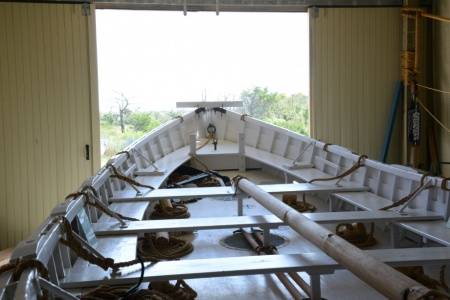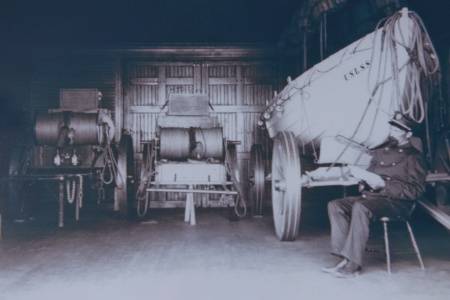

Before the Coast Guard was formed in 1915, the U.S. Life-Saving Service was tasked with life-saving missions.
One of the most historic life-saving stations is located in Rehoboth Beach, Delaware, nestled between the Atlantic Ocean and Rehoboth Bay. Built in 1876, the pumpkin and cranberry-colored structure captures the essence of its roots as a maritime museum.
The preservation of maritime history is vital in order to appreciate the modern day seagoing services and their continued efforts to protect the nation’s waterways. Park interpreters use demonstrations to explain the station’s history to their visitors in order to keep the tours exciting and engaging for all age groups.
Laura Scharle, the interpretive programs manager at Delaware Seashore State Park, helps to preserve that history.
“This coast has so much history — people don’t realize what was going on around the turn of the century and before that,” said Scharle. “Our station and crew alone responded to 62 shipwrecks and saved over 419 lives — that’s not even counting all of the other Delaware stations.”
The park has a museum filled with historic maritime artifacts. Some were donated by organizations while others are on loan from park supporters. One such piece is the breeches buoy apparatus. The breeches buoy is a life ring with canvas breeches attached, which when suspended from a rope, can be used to transfer a person to safety from a ship to land. The apparatus was used when it was too dangerous to launch a surfboat and the vessel in distress was within a few hundred yards of the beach.
“The Life-Saving Service came up with this ingenious idea where they would fire a line out to the ship with a small cannon called the Lyle gun and then rig up a whole set of lines that act like a continuous clothesline system,” said Scharle. “They sent up the breeches buoy up a thick line called the hawser, which is attached to the mast of the ship, to bring them safely down to shore.”
Coast Guard members and the staff at Indian River Life-Saving Station perform demonstrations in front of crowds gathered at the Delaware Seashore State Park. Incorporating the Coast Guard in the breeches buoy demonstration brings to life the transition from old-school rescue techniques to present day methods.
“I like doing the demonstration because it helps us share our heritage and shows how search and rescue got started,” said Petty Officer 3rd Class Jeremy Hatley, a boatswain’s mate at Coast Guard Station Indian River Inlet. “A lot of people don’t know what we do or where we came from, so when you take a demonstration like the breeches buoy and get a lot of people out here, especially kids, that gives them the opportunity to learn and see something exciting.”
Workers at the park showcased the breeches buoy demonstration numerous times throughout the summer in order to educate visitors on 19th century life-saving techniques. One park interpreter educates the crowd on the station’s history while the other workers prepare the Lyle gun and lines for the breeches buoy apparatus.
“We do kayak tours, bird walks and even lantern tours, which is a nighttime program here at the station,” said Lowell Markey, a park interpreter. “We take people through the station after dark and issue everybody a lantern and walk out on the beach for a patrol.”
In 2014, the park started a new program called Lifesaving: Yesterday and Today. It’s a daytime program where two of the park interpreters give a tour of the 1876 Lifesaving Station followed by a tour of a modern day search and rescue station. It helps bridge the gap between how it was done in the past and how it is done now.
“The yesterday and today program includes a detailed tour of Coast Guard Station Indian River and even getting on their boats,” said Markey. “It’s quite an interesting program for all ages.”
Delaware Seashore State Park holds a unique place in our nation’s maritime history. The park employs knowledgeable and enthusiastic workers to educate the visitors on a wide range of topics. Whether it’s bird tours or historic zip line demonstrations, Delaware Seashore State Park has an abundance of history and knowledge.
“I hope to be in this role for many more years — I love it here,” said Scharle. “One day I’ll hand the keys to someone else — I don’t know when that will be — but I hope what we are doing now continues.”



